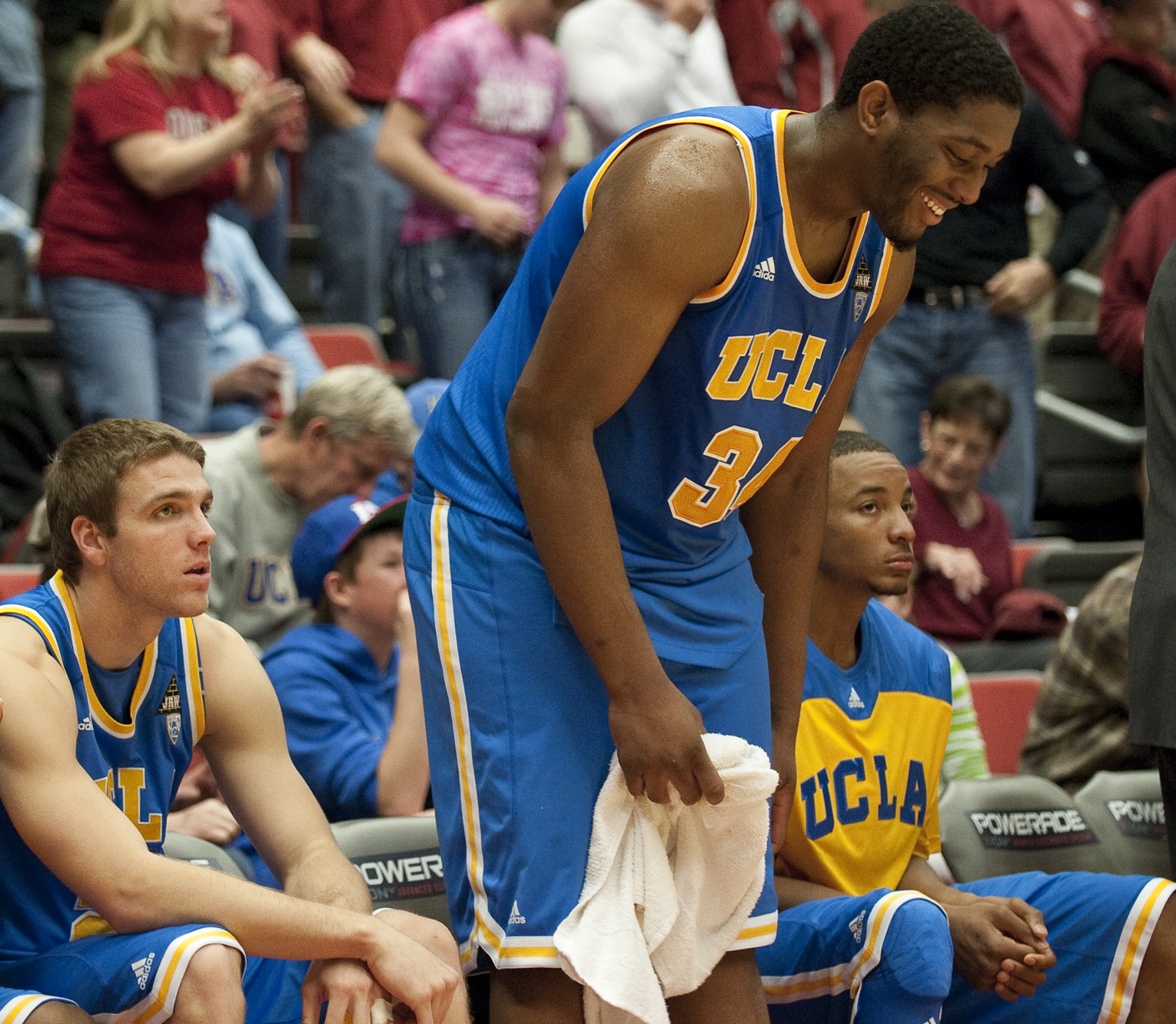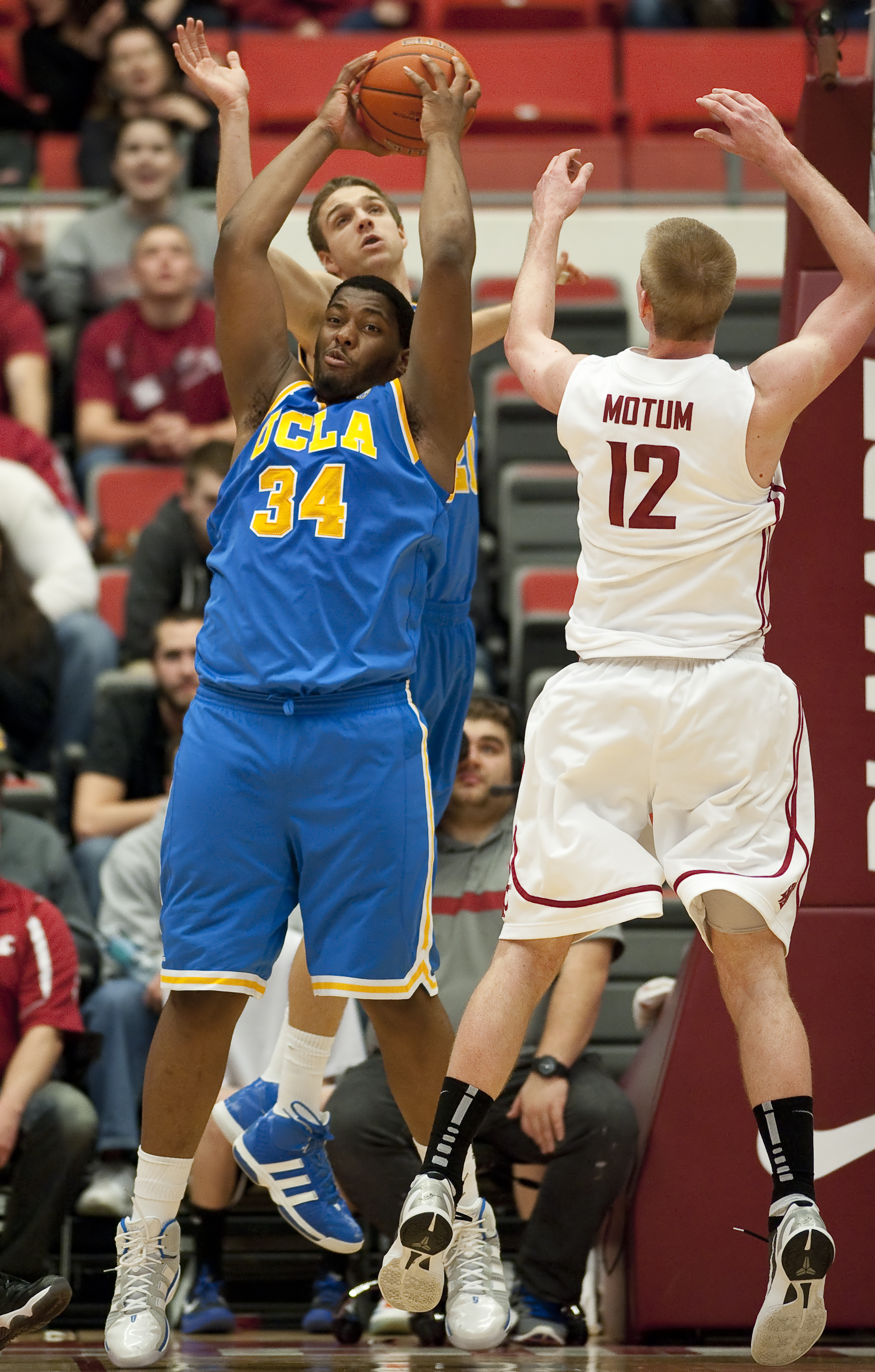
Joshua Smith toys with Washington State fans as he pretends to sit down after fouling out of the game. Smith scored 19 points to lead the Bruins to their first road win of the season, a 63-60 victory over the Cougars.
During games he tugs at his jersey constantly, as if it’s holding back the enormous amount of potential inside.
For better or worse, that uniform remains snug on Joshua Smith.
The UCLA sophomore’s greatest asset is his size, giving him the ability to overpower opponents. Teammates swear that there’s no player in the country that can guard him one-on-one, which is why the 6-foot-10-inch center frequently sees double teams.
The numbers don’t suggest that he would be the focal point of a defensive game plan. Smith is UCLA’s third-leading scorer, barely averaging double figures in points, attempting the sixth-most shots on the team.
But on Saturday, Smith was once again harassed by California’s extra defenders.
That’s where that tight-fitting jersey begins to tell a different story.
His weight was once listed at 330 pounds before quickly being amended to 305, the number Smith has remained listed at in two seasons at UCLA.
That figure ““ in both senses of the word ““ has been far from constant. Smith’s weight, and more importantly his fitness, remains a riddle, wrapped in a mystery, inside a UCLA jersey.
Consider these juxtaposing sound bites from early December.
From UCLA coach Ben Howland: “I think his conditioning is way behind where he was last year at the end of the season.”
From Smith, on the same day: “Honestly, how I feel right now, I feel like I was in better shape now than I was last year.”
With UCLA’s inside-out style of play, Smith always has a chance to leave a major imprint on the Bruins’ games.
For someone touted as a superstar, Smith averages the minutes of a sixth man. His time on the court is down, much like most of his stats from a year ago, to just 18.4 minutes per game ““ not even half a regulation contest.
When he first arrived on UCLA’s campus in the summer of 2010, Smith dedicated himself getting in shape, to the point when he wasn’t even focusing on basketball.
His conditioning remained a work in progress, though by the end of the year he was averaging almost 27 minutes over his last 10 games and wreaking havoc in the post during the Bruins’ two-game cameo in the NCAA Tournament.
The summer of 2011 was different. Smith worked out at UCLA and took classes during Summer Session A, then went back home to Washington for Session C, while most of the Bruins were going up against NBA competition in the Student Activities Center gym.
Howland set a goal for Smith to cut his frame down to 12 percent body fat by the start of his sophomore season. At the team’s media day, just before the first official practice, Howland declined to reveal Smith’s body fat percentage.
Howland’s “no comment” spoke volumes, but not like Smith’s play did. UCLA’s key cog was expected to have a sophomore surge, but instead regressed.
Meanwhile, Smith hung his head, with one sloppy play and a bad result begetting another.
“It’s just in my body language,” Smith said. “I’m just one of those guys, when the game’s not going that well, I get down on myself. I don’t like to lose.”
Along the way, Smith has shown only glimpses of the player he was touted to be.
A winter break devoted to trimming his body resulted in what Howland said was his lowest weight of the season to date. And, not so coincidentally, a dunk-filled 18-point outburst against Arizona State.
“For him, it’s a six-month process,” Howland said of Smith’s conditioning. “It’s not a two- or three-month thing.”
Then came a triumphant return to Smith’s home state: 43 points and 14 rebounds over two games, including a career-best 24-point performance in Seattle, a short distance away from his hometown of Kent, Wash.
“For me to be the player I know I can be, it’s just going to have to be a sustained effort,” Smith said after UCLA won its first road game at Washington State. “Last year was the same. I would have big games where I scored 19 against a team, then I scored six.”
His statement was almost prophetic.
Smith couldn’t sustain his effort and followed his homecoming with a sloppy seven-point showing against Stanford during which he played just 13 minutes because of four fouls, all charges on offensive moves in the post.
UCLA won despite Smith, but couldn’t do the same two days later against Cal when Smith once again had four fouls and was frequently targeted by the Bears’ pick-and-roll offense.
“Our design was to get Josh Smith into foul trouble,” said Cal coach Mike Montgomery, echoing the sentiments of many an opposing coach. Smith has averaged 3.2 fouls per game over his UCLA career.
Asked what the Bruins needed to do to get Smith to build on his play in Washington, senior guard Lazeric Jones instead pointed to something Smith did, and will need to continue to do: Stay on the court.
If he does that, there’s not much the Bruins have to do apart from getting Smith touches and clearing out to let him operate.
“He was on the court,” Jones said of the Washington game. “He played good defense, and he wasn’t in that much foul trouble early. So we were able to keep him out there.”
Maybe the biggest positive that came out of UCLA’s loss to Cal was Smith playing a season-high 29 minutes, though Howland said his center looked “tired and spent.”
Through the battery of questions related to his weight and conditioning and the constant nagging by Howland and the support staff, Smith has slowly slimmed down this season while trying to keep his level of play up.
“Now he’s seen if I’m not doing that, I’m not playing to my potential,” Howland said.
“We all know what his potential is, but what if?”
Howland stopped short of continuing his question, leaving it as limitless as the potential his talented center has.
